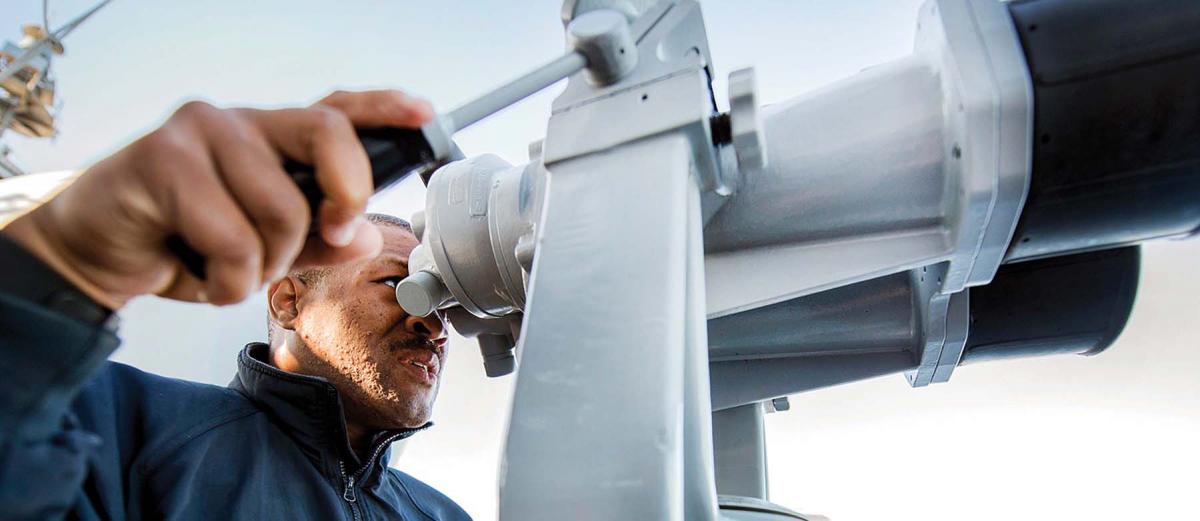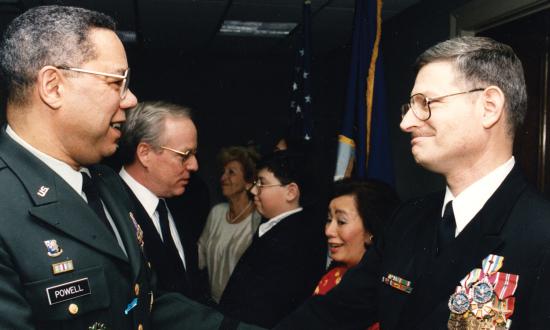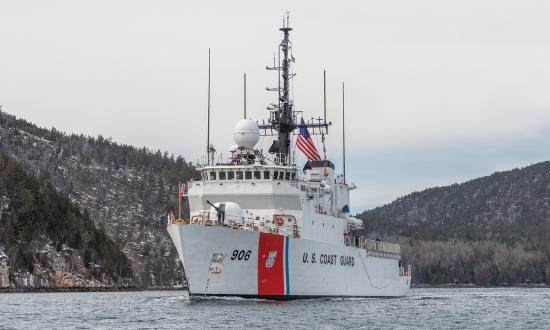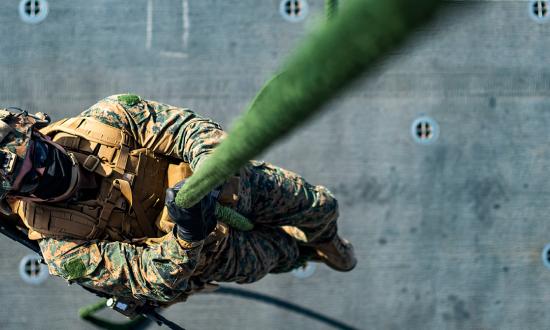They Are Not ‘Broken Shower Shoes’
Our Navy is at its best when officers and enlisted personnel are allowed to learn and grow from their experiences. I say “experiences” rather than “mistakes,” because there often are mitigating circumstances in favor of the person who has been held to account. If an “experience” is allowed to become a career-ending event, everybody—the individual, the ship/station, and the Navy—loses.
—CDR Robert H. Downie, USNR (Ret.)
Great Power Competition Requires Theater Deterrence
The Admiral writes that we must be able to “overmatch an opponent” in key theaters, particularly the South China Sea and North Atlantic; additional forces are needed for “zones of concern,” including the Arabian Gulf and eastern Mediterranean.
Given our current naval order of battle, this is not a valid strategy. Our principal power projection platform is the fleet aircraft carrier, and the Navy has only 11. The rule of thumb is one forward, two back, and two in overhaul. We thus have three carriers available at any given time for a presence mission, so—at best—we can concentrate two carriers in one of the key theaters. That is not “sufficient combat power within a given geographic theater . . . to overmatch an opponent,” especially in the South China Sea. Rather, our forces will be hostages to fortune, at risk to the calculations of our enemies, who have the initiative to strike at the time of their choosing.
With the approaching 80th anniversary of Pearl Harbor, it is worth noting that, had the fleet not been forward deployed to Hawaii, the Japanese could not have struck. As Admiral J. O. Richardson argued at the time, the Navy was a greater threat held back and so able to strike at the time and place of its choosing. That is still the appropriate strategy.
—CAPT Rick Jacobs, USNR (Ret.)
The Coast Guard Must Embrace the Fourth Industrial Revolution
Good job to Lieutenant Commander Pecora.
As the former Acting and Deputy Administrator of NOAA, I supported our elimination of paper charts; she offers it as a forcing function for the Coast Guard to do the same. I also led the development of six strategies for uncrewed systems, artificial intelligence, bioinformatics, data, cloud, and citizen science. These help realize the kind of transformational improvements in mission accomplishment that she envisions for the Coast Guard.
NOAA is one of the Coast Guard’s closest mission partners, and the Commandant—Admiral Karl Schultz—and I met several times to discuss how we might strengthen and expand technology collaboration between our two organizations. Lieutenant Commander Pecora makes a great case for doing this sooner rather than later.
—RDML Tim Gallaudet, USN (Ret.), CEO, Ocean STL Consulting
The Navy Lacks a Culture of Purpose
Commander Moses writes about the Navy’s corporate culture. The Navy is made up of multiple warfare subcultures. For the most part, all are alive and well—with the glaring exception of surface warfare. Surface warfare is the dragging anchor harming the Navy. It needs a true world-class center of excellence, probably at Newport, Rhode Island. It should have a statue recognizing the great Admiral Arleigh Burke, the surface warfare hero of World War II. It also should have a memorial to the 17 sailors killed in the 2017 collisions in the Pacific.
In the meantime, to implement a world-class surface warfare corporate culture, the Navy should take several steps:
All surface warfare officers (SWOs)—including SWO flag officers—should be required to take and pass the Coast Guard’s rules of the road test annually, and grades should be published for all to see. Low grades should require retesting.
All SWOs O-6 and below must maximize their bridge time and document it in individual logbooks. Each also must have an annual minimum of one week of bridge simulator time that includes the 2017 collisions and practices safe navigation in key high-traffic areas.
The following individuals should be invited to serve on a corporate culture advisory team: Victor Davis Hanson, noted military historian and commentator; Dr. Larry Arn, president of Hillsdale College; the presidents of Costco, Home Depot, Walmart, Edward Jones, The Mayo Clinic, and similar well-run entities; and the heads of naval aviation, submarine warfare, Naval Special Warfare, and the Marine Corps. The team should include a thorough review of A Report on the Fighting Culture of the United States Navy Surface Fleet.
Colonel David Hackworth, a highly decorated U.S. Army infantry officer in the Vietnam War, warned the public about overly political and incompetent flag officers, whom he called “Perfumed Princes.” They can be found in many places. The surface warfare community has been a breeding ground for them during the past 20 years.
Commander Moses says sailors should ask the question: “Why am I here?” The answer is: “Putting ordnance on target.” That is the bottom-line answer for every person in the Department of Defense.
—CAPT Al Melvin, USNR (Ret.)
Escaping the Innovation Bunker
Dr. Hale’s essay could ultimately become one of those watershed papers that changes everything, even in fields far removed from naval innovation. Her insight into the human communication aspects of the innovation process may be original synthesis in the fields of cognition and social behavior. Her practical examples of the three concepts discussed (conversational communication, diversity in networking, and the key role of interpersonal relationships) constitute a fresh perspective on institutional efforts to achieve intentional innovation.
In relating what worked and why in development of the tank, she wrote a much more illuminating and persuasive paper than if she had relied on failed programs’ dry after-action/lessons-learned reports. It is sometimes harder to discern what worked than what did not. What worked in 1915 was a happy coincidence of exceptionally strong-willed advocates with an unarticulated and unplanned innovation process. Dr. Hale’s paper unearths key concepts in that serendipitous historic process that must be harnessed to achieve the kind of intentional innovation needed to address a multitude of challenges today.
During my second career in the defense industry, I provided operations research/analysis support to tens of programs and system concepts seeking to turn cutting-edge technology into useful fielded systems. The infant mortality of new ideas is astonishingly high.
In many cases early-stage concepts, instead of being encouraged, are prematurely discarded because they are not “what ‘the flag’ asked for this morning.” Such failures are not about the technology, but about a lack of imagination. The flags might be interested in something tomorrow if they learn about it in an operational context.
The Department of the Navy needs to redefine and institutionalize its innovation channels by making them suitable for conversational communications with those of only above average determination. Stop throwing away ideas because the geek proposing it has never made a trap or stood a bridge watch! Instead, take the time to explain what it’s like to make a trap.
—Don Chappell
Fallen Stars
After commanding officers (COs) are relieved for doing something they thought right but that ended badly—collision, allision, grounding, etc.—do they become useless? These men and women are fallen stars. The Navy’s fallen stars did not get to command by being mediocre. They were and are great men and women who were screened, vetted, and found worthy of command.
Should they succumb to the same fate as fallen stars in nature? No, they are still valuable. They have a perspective many do not, including the leaders of our military, who have not faced relief, sidelining, or involuntary retirement.
During leadership and bridge resource management courses, prospective COs read case studies and watch reenactments of collisions and groundings. What is missing from such training and case studies are the thoughts and perspectives from the “man in the arena.” Seldom do we hear from those whose decisions ultimately led to these incidents. After they are relieved of command, they are often reassigned to an administrative job until they retire, rarely to be heard from again.
Current and future COs are missing out on the insight, thought process, mind-set, etc., that the case studies or the simulator reenactments do not convey, and this could be the most valuable part of the training. Were these COs under pressures that cannot be extracted from a bridge recording? What did they see or think that is not evident by reading the case study? There is clearly a piece missing from the puzzle. If what we see, hear, and read in the aftermath reenactments is all there is to know about an incident, it probably would not have occurred.
These fallen stars still have value to the Navy. Their perspective is not being heard, and, worse, it may not be asked for. Well—I am asking. Can we bring to the stage those COs whose decisions in command led to collision, grounding, or mishaps so that we might learn from them?
—CDR Lennard Cannon, USN
Nothing Illusory About Command of the Seas
Mahan’s Illusory Command of the Seas
Dr. Friedman suggests that my article misinterpreted America’s perhaps greatest sea power advocate. As I noted that far fewer people have read Mahan than seem to be an expert on him, Dr. Friedman should perhaps have read my column more closely, focused less on the title (which was written by an editor), and done a bit more homework, especially on Japan’s surrender and shock and awe.
First, Mahan was a historian, not a strategist. It falls to others to determine how his history translated into strategy—often wrongly. Second, the seas are largely uncontested unless superior naval forces are present. Third, navies are necessary but not sufficient to win wars by themselves. Trafalgar and Midway are examples of this truism. And finally, Mahan’s notion of a “decisive” naval battle terminating or ending a war, not merely laying the predicate for victory, is illusory, at least during the past 200 years.
Regarding “shock and awe,” it is too bad Dr. Friedman relied on headlines and not what this doctrine explicitly stated and meant. Iraqi Freedom was the anti-thesis of shock and awe, whose aim was to win without fighting or with minimum use of force. Instead, it became a slogan employed by General Tommy Franks, the only U.S. general to preside over two failed wars. And for the record, I opposed the war first on the grounds Iraq did not possess weapons of mass destruction and, later, over the misrepresentation and misuse of shock and awe.
About Japan’s surrender, if Dr. Friedman reads the minutes of the two Imperial Cabinet meetings of the Supreme War Council after Hiroshima, when the decision was made to continue the war, and then, after Nagasaki, when Japan would accept unconditional surrender, it is clear that the unprecedented damage done by two nuclear bombs from two single B-29s was incomprehensible to the Japanese generals and particularly the Emperor. Indeed, Japan was “shocked and awed” into capitulation.
—Harlan Ullman
Rules for Safe Electronic Navigation
Each issue of Proceedings brings an educational item or a memory of my maritime days. This article reinforces the need for mariners to look outside.
As the second mate on a Grace Line C-4 cargo ship navigating south toward the Mona Passage in 1968, I took a “perfect” five-star fix that showed us four miles west of the course line and west of the LORAN position fix. Hmm, which to trust? I put a seaman on the bow to look and listen. It turned out the star fix was correct. If we had just relied on LORAN, we would have grounded on the Dominican Republic. The article reinforces the need for mariners to always double-check their electronics—and also look outside.
—Thomas W. Harrelson
Close the Door on Gender Barriers
I have seldom read an article with which I have disagreed more. Well, I do agree that to win, we must “retain, promote, and select” our top performers for the most demanding assignments; however, I do not agree that “our best women” do not stick around because male leaders make it “difficult for female sailors and Marines to serve a full career in uniform.” Nor do I believe that a failure to mentor women is the cause.
Our best women stay in or get out because they simply chose to do so and for many reasons. As for mentors, Marines should be concerned about being professionally competent, seek out demanding assignments, maintain the highest standards in personal conduct and fitness, study, and care about Marines. Having a mentor is nice, but it is not something that most Marines should worry about it.
Next, the author’s belief that gender- neutral scores on the physical fitness test (PFT) will somehow reduce male bias is, well, nonsense. First, men and women are different. All Marines understand this, and most accept it. The author’s belief is that “with time and effort, most service members can excel at their fitness tests, regardless of gender.” That’s true, as long as the standard scores are different; that is, not gender neutral. For sure, there are a few women who can perform physically with most men on an equal basis; but most women cannot, and to force them to be judged on the same PFT standards as men is to force them to fail. The Army is trying this with disastrous results. At every sports level (high school, college, professional) men and women compete separately. Let’s not attempt more social engineering; keep separate scoring standards.
Last, the author states that integrating men and women at recruit training is a “victory.” Yes, the Marine Corps will make it work, because they have been told to do so, and active-duty Marines had better fall in line or be left in the dust without mentors. But is there a need? Is this simply more social engineering to please a few in Congress? Will the cost and the changing of our long-standing success in making Marines make our Corps more combat ready and better able to accomplish its mission? I doubt it.
—Col W. M. Rakow, USMC (Ret.)
Unmanned Ships and the Future of Deterrence
I greatly enjoyed Dr. Wirtz’s excellent commentary. Unchecked, the allure of efficiency and increased combat potential leads to ever-increasing capability in single platforms. In mathematical terms, it sometimes seems that the limit of all surface combatants as time approaches infinity converges to an Arleigh Burke–class guided-missile destroyer (DDG). Though excellent platforms, DDGs (and the upcoming FFG-62 frigates) will not be the right tool in every instance.
Thus, I heartily support his well-reasoned and supported arguments for a complementary set of smaller, more numerous, possibly unmanned, and (hopefully) less expensive platforms for sea denial. However, his focus on missiles overlooks the value of offensive mining. Historical examples of the effectiveness of offensive mining abound, such as Operation Starvation during World War II.
Recent submissions in these pages make strong arguments in favor of developing the technology and proficiency to take advantage of offensive mining, with arguments from seniors and juniors alike. In addition, offensive mining offers the potential to fill gaps when surface combatants large or small are unavailable. The ability to deploy them from a variety of platforms only increases their versatility. In Military Strategy, J. C. Wylie stated that the determinant of control in war is the man on the scene with a gun. In sea denial, it is the weapon on the scene, and mines should be considered alongside missiles to that end.
—Victor Sussman
As a life member since the early 70s, I closely follow developments in the U.S. Navy and Marine Corps. Lately, I have focused on the most interesting changes within the Marine Corps under the guidance of Commandant General David Berger. They make a lot of sense with regard to the South China Sea and maybe to other Southeast Asian environments.
From the European and particularly from the Baltic and Norwegian perspective, however, I do not understand at all eliminating all tank battalions (with their still powerful M1A1s) and most tube artillery. I believe the Corps still has a high-end role to play in that area, as it did during the Cold War. The Corps may still even have some material, equipment, and weapons stored in Norwegian depots.
Without neglecting potential cyber and special operations activity, current threat perceptions in the Baltic region and Scandinavia still consider a Russian conventional attack a possibility, assuming Russia would consider a forceful change in that region of Europe. Even Sweden is concerned with aggressive actions across the Baltic Sea.
But hard power still counts here, including armor and heavy artillery. Poland is procuring more than 200 U.S. M1A1 Abrams tanks, and NATO countries have stationed conventional units in the Baltic States with trip-wire roles. NATO (including Germany) earmarks armored units for potential conflicts in Eastern Europe and the Baltic.
I am wondering how General Berger plans to use his Marine Corps forces in that area of the world without Abrams or 155-mm artillery. Is this—because of the U.S. emphasis on China—the first step to withdraw from the traditional reinforcement and defense roles in Northern Europe and the Baltic? That would be a terrible message to Russia, in a very bad moment.
—Col. Jürg E. Kürsene, GS (Ret.)







